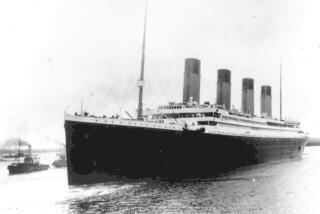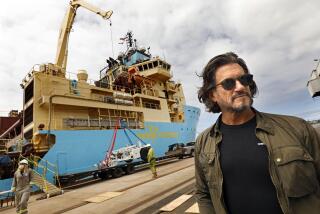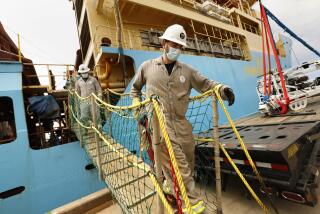Highest Technology for Lowest Depths
- Share via
It was September 1985, and Robert Ballard was in a research ship that had been crisscrossing an infamous patch of the North Atlantic Ocean. He was peering into a television monitor at images sent up from a special low-light underwater camera in tow beneath the ship.
The camera was sending up video images of a cold and barren seabed 12,000 feet below. Ballard’s goal: to find the wreck of the Titanic, the “unsinkable” ship that went down in 1912.
It was Ballard’s second expedition in search of the ill-fated luxury liner. The previous year he’d looked for a month with no luck, and the new search wasn’t going any better.
“The bottom was just going by and going by,” Ballard recalled. “And it’s a boring bottom.” To ease the monotony, someone was playing a tape of “I Heard It Through the Grapevine.”
Finally, a trail of debris appeared on the video monitor. Since German U-boats had sunk countless ships in the North Atlantic during World War II, Ballard and his colleagues couldn’t be sure if they’d found what they were looking for.
Then, a great ship, broken in two but sitting upright, came into view. “We saw the ship’s boilers and we knew it was the Titanic,” Ballard said.
It was a moment that set Ballard alongside the most famous explorers of this century and helped him toward one of the most coveted prizes in the profession, the Hubbard Medal of the National Geographic Society, awarded to him last month. Not bad for a local boy: Ballard grew up in Southern California--San Diego and later Downey, where he graduated from high school.
Ballard’s discovery of the Titanic and the sunken German warship the Bismarck, as well as his unprecedented finding of ancient Roman galleons in the Mediterranean in 1988, are part of an emerging discipline that Ballard has helped create: deep-water archeology.
The deep ocean, it turns out, with its extreme cold, darkness, low levels of oxygen and paucity of biological activity, is a superb preserver of sunken ships--and the priceless historical artifacts they often contain.
“We realized through the Titanic how well history is preserved in the bottom of the ocean, but technology is only now allowing us to explore at those depths,” Ballard said. “There’s more history preserved in the deep sea than all the museums of the world combined.”
None of this exploration would be possible without several recent advances in various technologies, including fiber optics, remotely operated vehicles and cameras designed with the same light-intensifiers developed for night-vision instruments used by the military.
Though deep-sea research vehicles have been around for decades, manned exploration of the ocean floor is arduous and inefficient at best, requiring several-hour commutes each way.
Ballard, 54, instead explores the depths through “telepresence,” a kind of virtual reality for scientists that uses a remotely operated submarine to serve as the eyes and hands for Ballard and his scientist colleagues.
Fiber-optic communications lines allow the robot submarine, officially called the ROV (for remotely operated vehicle), to send video from the ocean floor and allow scientists in ships at the surface to delicately control the vehicle’s movements.
“This enables us to have a sustained presence down there--an ability to go down and work long hours,” Ballard said.
Ballard, who trained first as an undersea mapper, also did a stint in the military, where he served on Navy submarines. Now he is on the faculty of the Woods Hole Oceanographic Institute in Massachusetts, where he is director of the Institute for Exploration, recently established to find antiquity in the deep sea.
Ballard’s next expedition will be to the Mediterranean, where he will direct the excavation of four sunken Roman trading ships that went down in about the 4th century, en route to Rome after leaving ancient Carthage (now Tunisia).
Among the artifacts are thousands of the tall jars known as amphorae. “‘No one has ever excavated a ship from 3,000 feet down,” Ballard said. “We expect it to be highly preserved.”
After that, Ballard heads to the Black Sea, where he’ll literally follow the path of the mythic explorer Jason, who took his Argonauts to seek the Golden Fleece. Sound like Ballard is mixing history and myth? It turns out that the Bronze Age residents of the coastal Black Sea actually panned for gold by dragging sheepskins through the water.
Ballard expects there will be more facts behind the myths in the cold time capsule of the Black Sea’s depths.
Still, Ballard does not call himself an archeologist.
“I think of myself as an explorer--that was always my career goal,” he said. “If I could go to Mars tomorrow, I’m gone.”
*
Freelance writer Paul Karon can be reached at [email protected]






